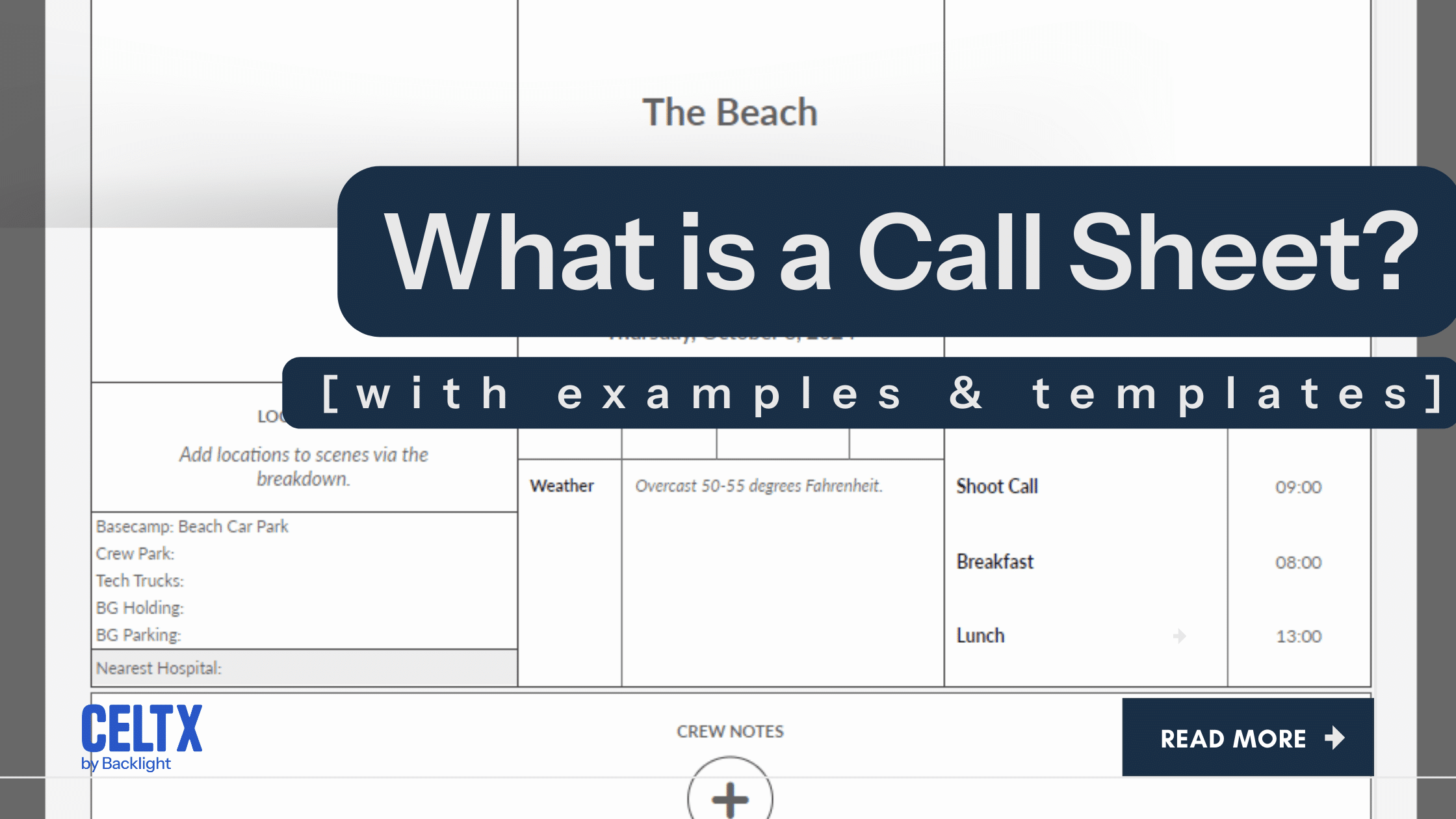
In the world of film, television, and video production, clear communication is everything. Whether you’re on a small indie shoot or a major set, everyone needs to know where to be, when to be there, and what’s happening next. That level of coordination is key to staying on schedule—and on budget.
Enter the call sheet.
If you’re new to production or just want a refresher, this post breaks down what a call sheet is, why it matters, and what details it includes. Once you’re familiar with the basics, you can dive into our step-by-step guide on how to make one for your next project—using tools like Celtx to keep things simple.
In This Article:
- What is a Call Sheet?
- Why Every Production Needs One
- Key Elements of a Call Sheet
- Celtx Call Sheet Templates
- Conclusion
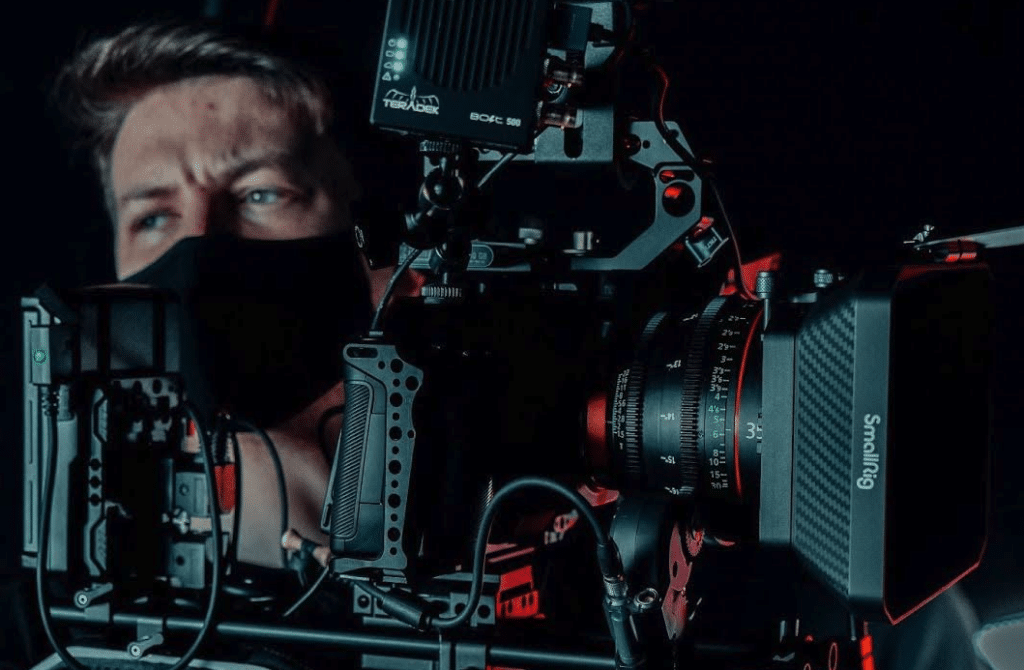
What is a Call Sheet?
A call sheet is a daily schedule sent to cast and crew during a film or TV production. It outlines who needs to be where, when, and with what — helping coordinate every department for a smooth shoot day.
Once a call sheet has been created, it’s distributed among the cast and crew, providing essential information such as call times, locations, weather updates, and safety protocols.
The call sheet is usually prepared by the assistant director (AD) or production coordinator and is typically sent out the night before. It keeps everyone informed and organized; there’s nothing worse than arriving on a busy set with countless cast and crew running around with no clue as to what’s going on!
Why Every Production Needs One
Whether you’re on a small indie set or a big-budget movie, call sheets are indispensable resources. Here are just some of the reasons why you need to utilize them for your next project.
Efficient Communication
Call sheets consolidate all the information needed for the day into one document. This not only eliminates confused but also reduced the likelihood of miscommunication.
In short, everyone knows where to be, what to bring, and what’s expected of them!
Time Management
With detailed, full schedules and various call times, call sheets ensure that cast and crew members are punctual and prepared for every single day.
Time is money in the fast-paced world of production, so being on time and ready is essential.
Logistical Coordination
From location details to transportation arrangements, a call sheet ensures that all moving parts of a production are in sync.
Accountability
Call sheets clearly outline key roles and responsibilities, making it super simple to identify who is in charge of what – and to chase them up if they don’t get things done!
Safety
With all those people and equipment present on set, emergency contacts, safety guidelines, and local hospital information are critical. If a problem does occur, having this information to hand ensures everything can be addressed quickly.
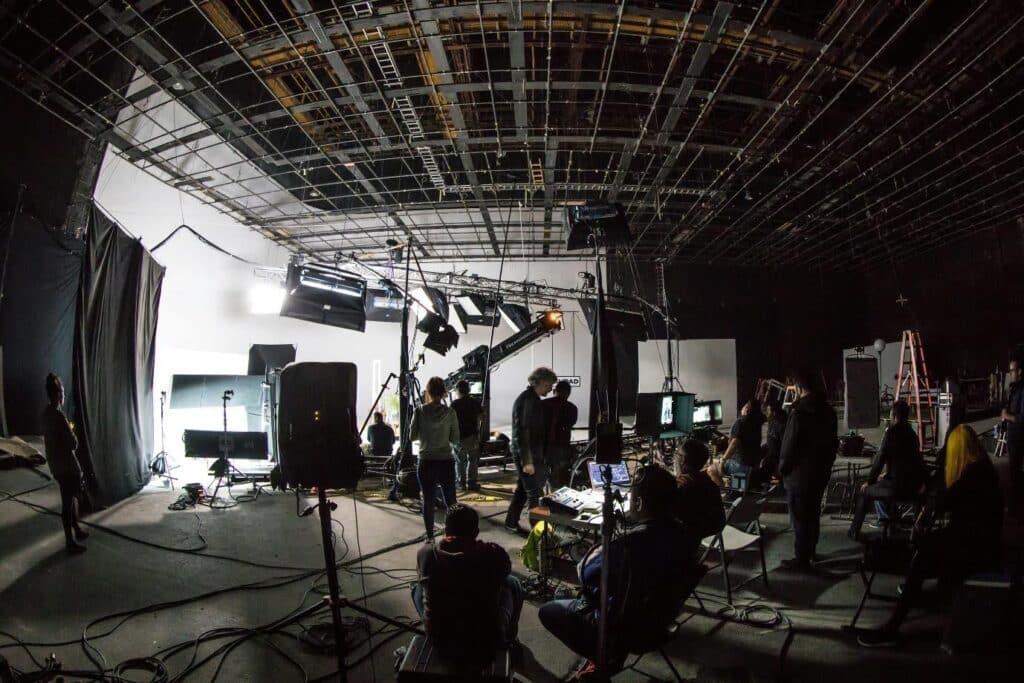
Related Reading: Script Breakdown | A How-To Video Tutorial with Templates
Key Elements of a Call Sheet
We’ve talked about the broad strokes of a call sheet but what exactly goes into a well-drafted one? Let’s break down the key elements of a call sheet:
Production Details
This is all the basic information you’ll need, including:
- The name of the project
- The shoot date
- Contact details for key personnel, for example the director, producer and AD)
Daily Schedule
The running times of the day:
- Call times for cast and crew
- Scene details and script pages to be shot
- Estimated wrap time (end of the day)
Cast and Crew Information
It’s crucial for everyone on set to know who’s who:
- Cast members, their roles, and specific call times
- A crew list with departmental responsibilities
Location Details
With some film shoots requiring multiple locations depending on the scenes that are being shot, addresses and location details are extremely important:
- Address and directions to set
- Parking information
- Nearby facilities
Weather Forecast
Being aware of weather conditions for the day is especially crucial when dealing with outdoor shoots.
Health and Safety
Again, with the sheer number of cast, crew and equipment on set, the call sheet needs to take safety extremely seriously. Information such as this needs to be within easy reach to all.
- Emergency contact numbers
- Nearest hospital or urgent care details
- COVID-19 guidelines or other relevant safety protocols.
Additional Notes
Call sheets can also include any special instructions or reminders for all departments. This could be anything from wardrobe, props, or equipment requirements.
Of course, we need to see a call sheet in action to understand how all this information comes together. Check out this call sheet example from an episode of Lost.

Now, let’s zoom in on the key elements of the call sheet, starting with the key members of the crew (top left-hand corner).
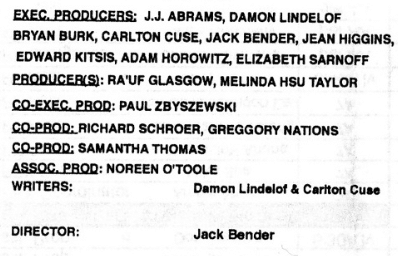
In the top-center is the leave time and crew call. This will be the start time for everyone on the crew, with key information on how to get from where the crew are based to the filming location, which is this instance is Diamond Head Studio.
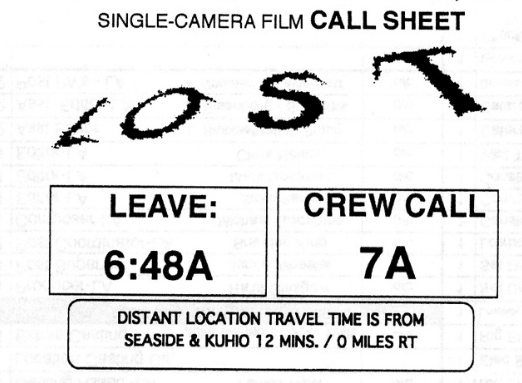
Next, in the top right-hand corner, the date, shoot timeline and weather details put everyone on the same page.
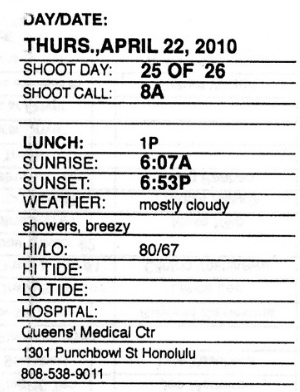
Under that, we have the scenes being filmed. Notice the scene numbers in the first column aren’t directly after one another. This is because they’re all being filmed on the tank stage (underwater!). Film productions will usually film all scenes at one location before moving onto the next to save time and money.

Notice the notes on the call sheet re. the wrap party and leftover boxes. Call sheets are a great place to communicate an important message to the whole cast and crew.
Finally, under the scene list, we have the actors.

This section details the actors, their character, their arrival time, their time for hair and make-up, ending with when they need to be ready and any special instructions.
The majority of the actors for this day’s shooting are on standby. As this is one of the last days of filming, the director may want to do some ‘pick-up’ shots, hence holding the actors in case they’re needed.
Here’s another fantastic example of a call sheet from the twenty-second Bond movie Quantum of Solace. Notice how the layout is slightly different to include stunt and stand in artists.
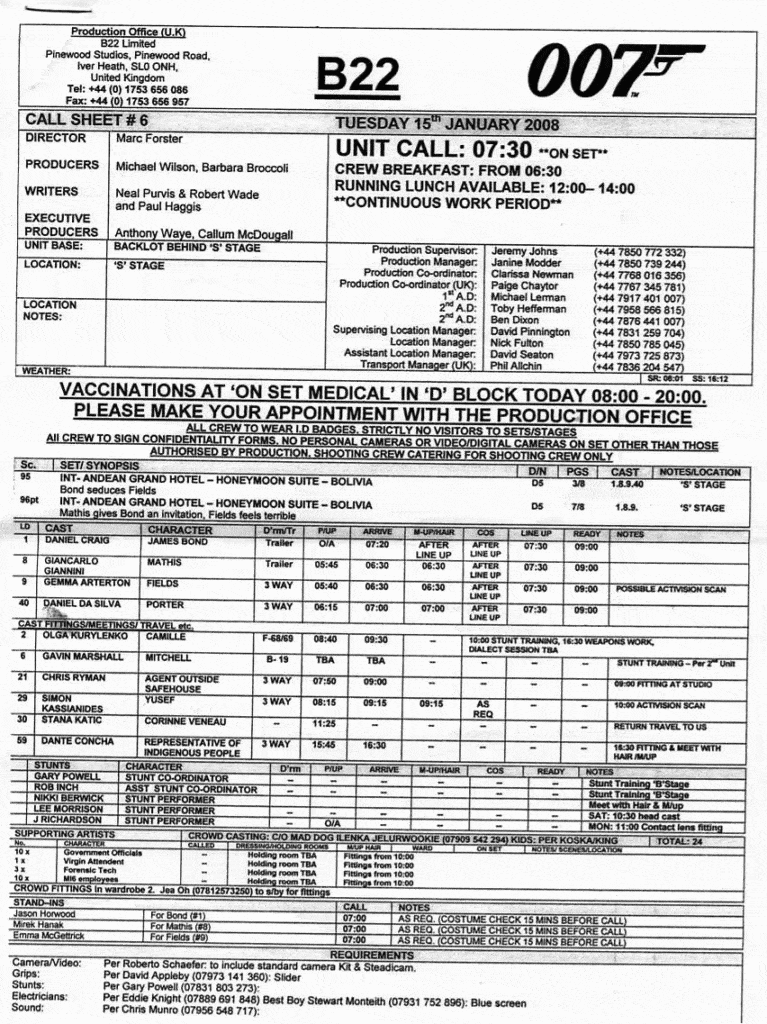
Another James Bond call sheet example is from 2002’s Die Another Day. Again, this is a slightly different layout, but the required information is the same.
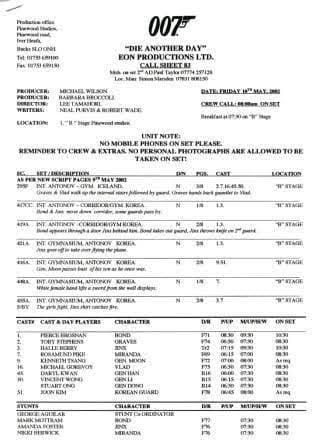
Wondering how to build one?
Check out our full guide on how to create a call sheet step-by-step.
Celtx Call Sheet Templates
“Wait! Did you mention call sheet templates?” we hear you ask. Why, yes, we did!
Celtx simplifies the process of creating professional-grade call sheets, ensuring you don’t miss any critical details.
Our call sheets are a complete game changer, as they’re fully customizable and can be tailored to your production’s needs.
Not only that, if you use Celtx to write your screenplay, you can seamlessly integrate it with our call sheet template. Fully intuitive, the call sheet automatically pulls relevant scene details, saving you time and reducing errors.
Continuing with the integration theme, once you’ve completed your call sheet, you can send it out directly from Celtx as well as easily distribute any updates and changes!
Plus, with many productions working remotely with cast and crew all over the world, Celtx’s cloud-based platform means your call sheets are accessible anytime, anywhere and from any device. Neat, huh?
To check out Celtx’s free call sheet template, head on over here and grab your free call sheet download.
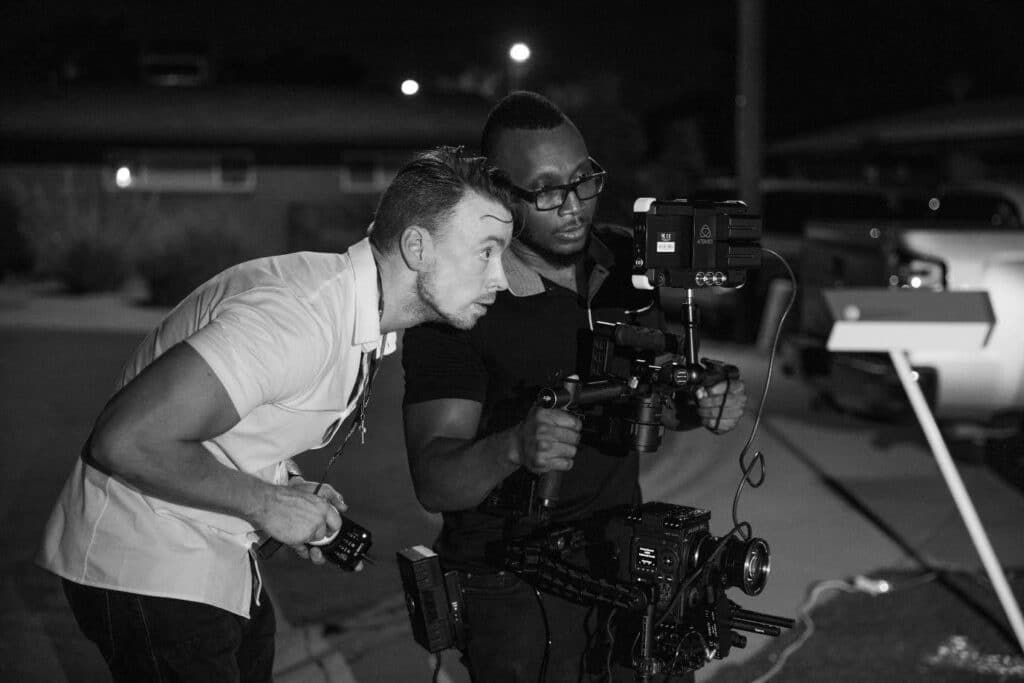
Conclusion
Call sheets are the backbone of any film, television, or video production. By providing a clear, organized guide for each shooting day, they ensure smooth communication, efficient time management, and overall logistical harmony.
Whether you’re working on a small indie film or a major studio project, call sheets keep everyone aligned and prepared.
With tools like Celtx, creating professional call sheets has never been easier. Ready to streamline your production? Start by creating your very own Celtx account and see what we have to offer!
Up Next…
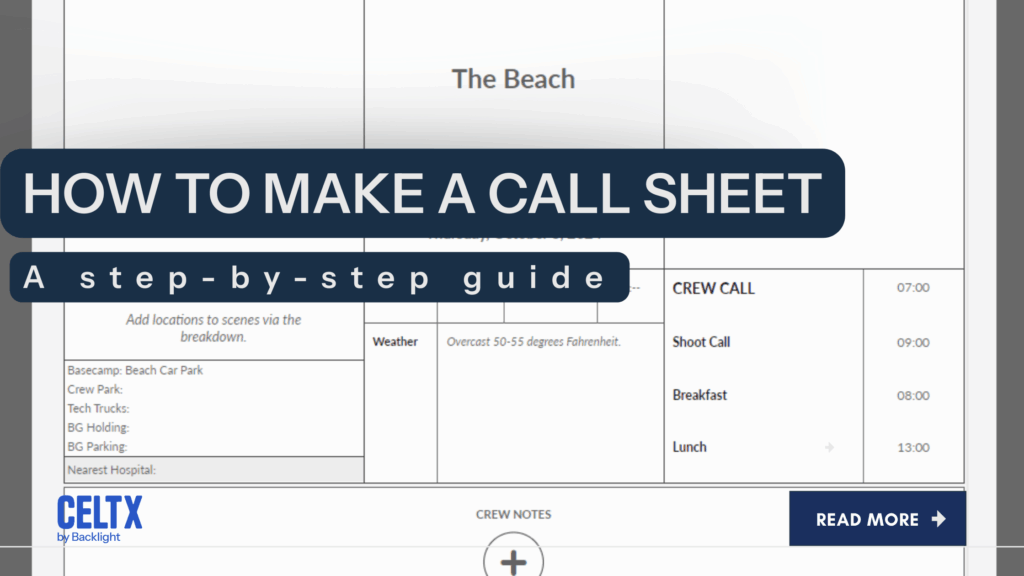
How to Make a Call Sheet: A Step-by-Step Guide
Learn how to make a call sheet for your next production with real examples, key elements to include, and tips for building one in Celtx.
You might also like:
- Film History: Call Sheets
- Celtx: Your Ultimate Tool for Creating an Efficient Shot List
- How to Block a Film Scene
